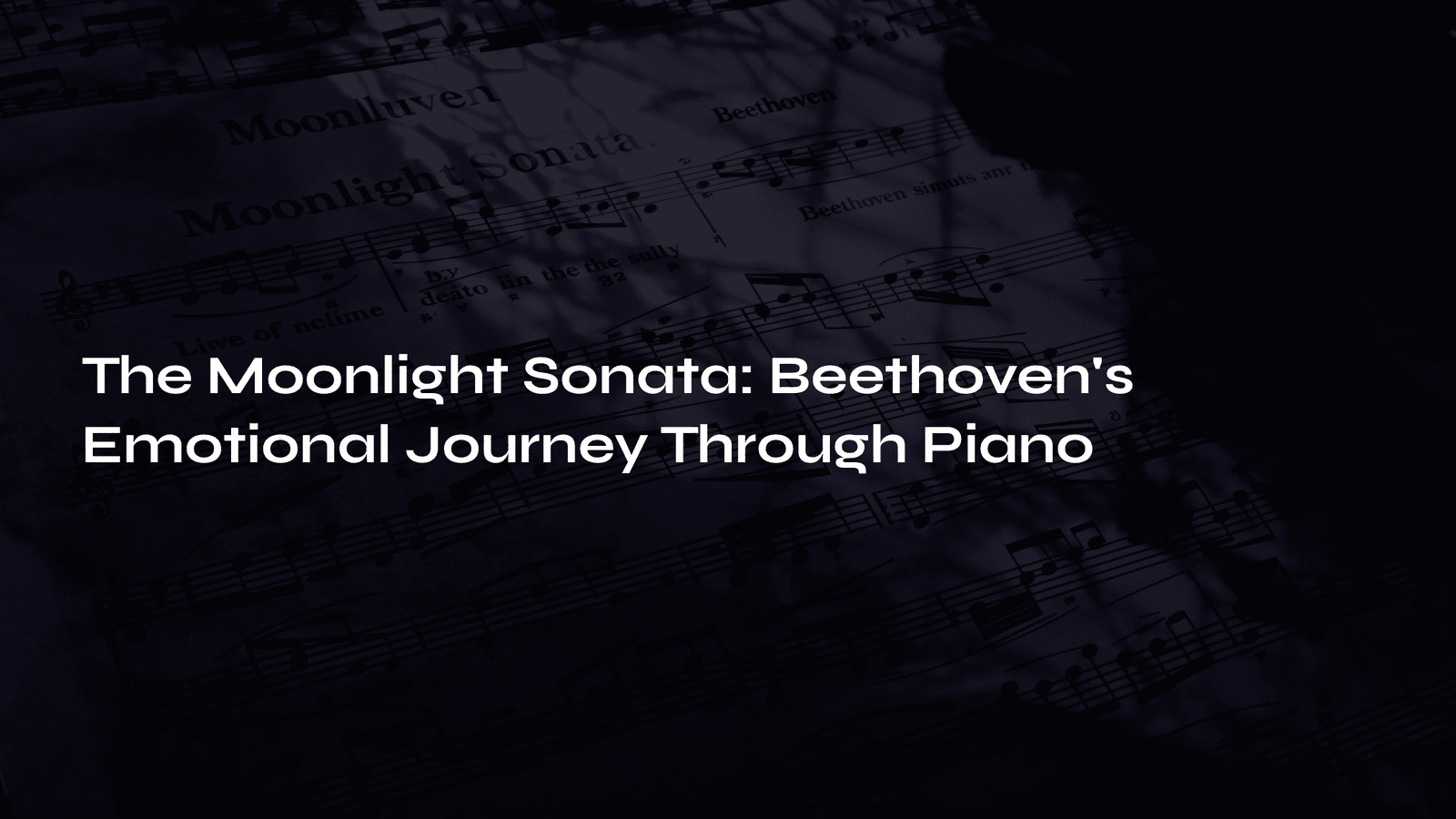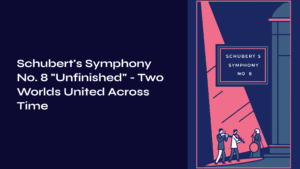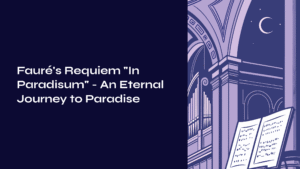Table of Contents
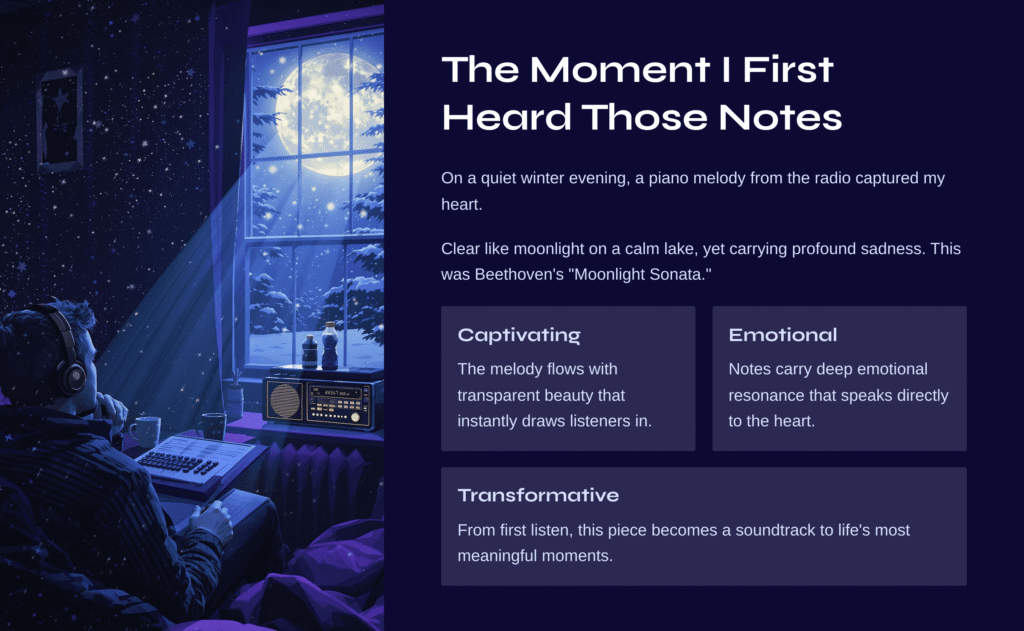
The Moment I First Heard Those Notes
On a quiet winter evening, a piano melody flowing from the radio captured my heart. Clear and transparent like moonlight falling on a calm lake, yet carrying a profound sadness within its notes. I later discovered this was Beethoven’s “Moonlight Sonata.” From that moment, this piece became the soundtrack to my life, and today I invite you to journey with me into the world of this beautiful composition.
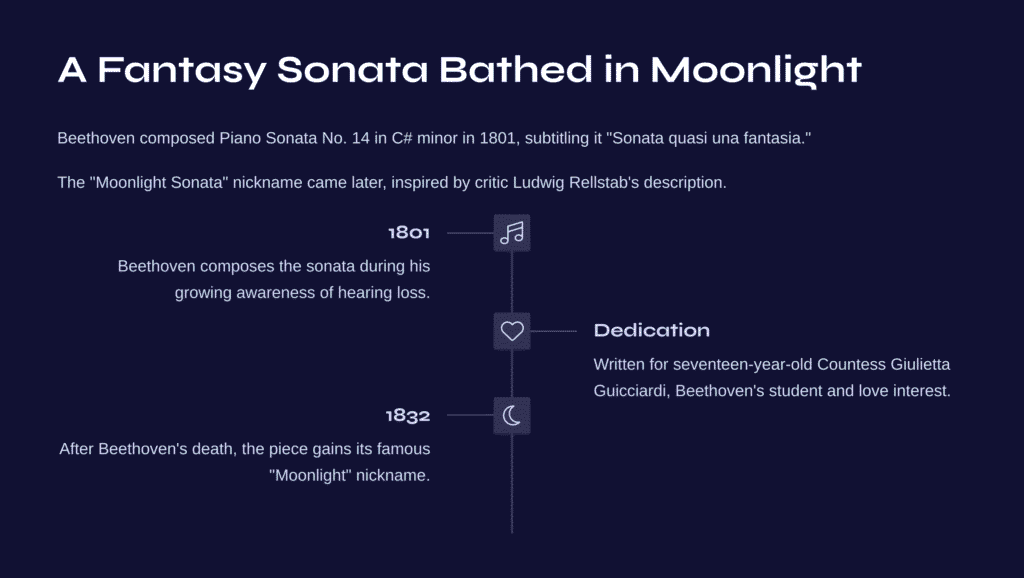
A Fantasy Sonata Bathed in Moonlight
Ludwig van Beethoven (1770-1827) composed Piano Sonata No. 14 in C# minor, Op. 27 No. 2 in 1801, originally subtitling it “Sonata quasi una fantasia” (Sonata almost like a fantasy). However, after Beethoven’s death in 1832, German music critic and poet Ludwig Rellstab described the first movement as reminiscent of “moonlight shining upon Lake Lucerne,” and thus the nickname “Moonlight Sonata” was born.
The piece was dedicated to one of Beethoven’s students, the seventeen-year-old Countess Giulietta Guicciardi, with whom Beethoven was reportedly in love. Fascinatingly, this work was composed during a tumultuous period when Beethoven was becoming increasingly aware of his deteriorating hearing. Perhaps within these beautiful melodies, we hear intermingled expressions of love, despair, and the deep internal conflict of a musician facing his greatest fear.
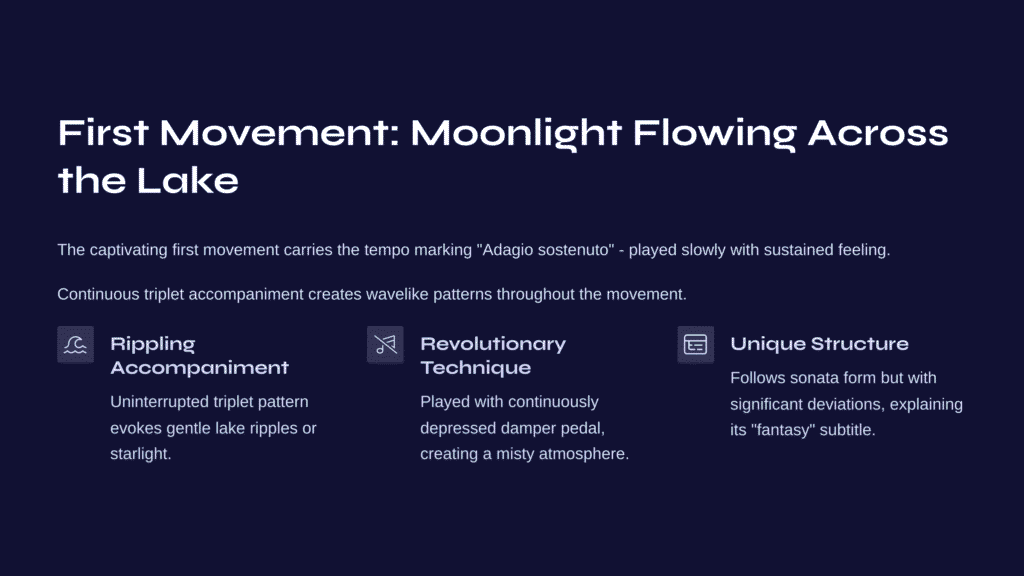
First Movement: Moonlight Flowing Across the Lake
What makes the Moonlight Sonata, particularly its first movement, so captivating? This movement carries the tempo marking “Adagio sostenuto,” indicating it should be played slowly and with sustained depth of feeling.
What immediately strikes the ear is the continuous triplet accompaniment in the piano. This wavelike pattern continues uninterrupted throughout the entire first movement. Like the gentle ripples of a lake or starlight in the night sky, this persistent yet subtly changing accompaniment underlies a clear melody with distinctive dotted rhythms in the alto register.
Beethoven instructed that this movement be played with the damper pedal continuously depressed (“senza sordini”), which was revolutionary for its time. This creates a misty, dreamlike atmosphere where sounds blend together.
While formally following sonata structure, it deviates significantly from traditional sonata rules. It maintains the exposition, development, and recapitulation structure, but features an unusually brief development section and unique harmonic progressions. This free approach explains why Beethoven subtitled it a “fantasy-like sonata.”
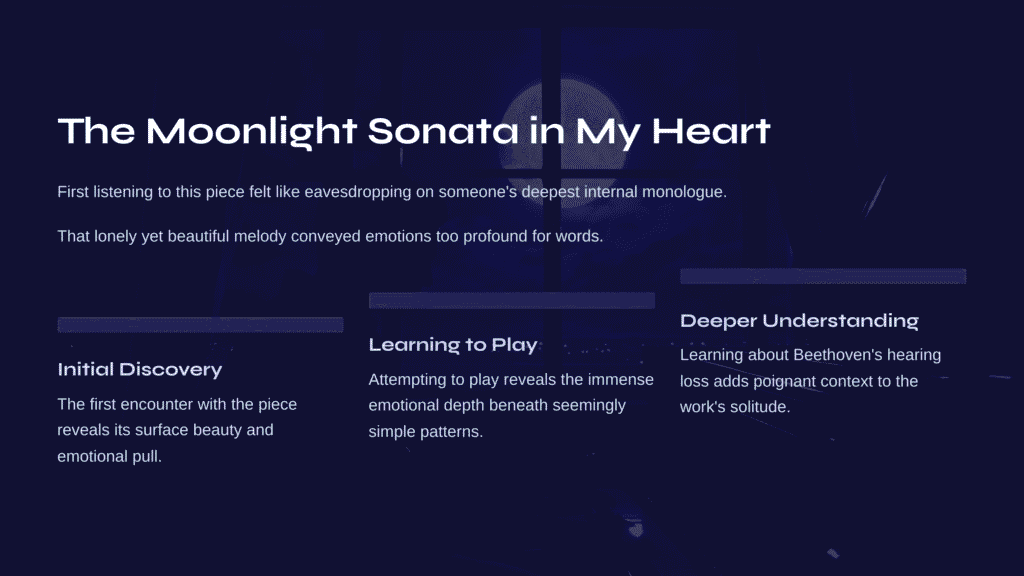
The Moonlight Sonata in My Heart
When I first truly listened to this piece, I felt as though I were eavesdropping on someone’s deepest internal monologue. Particularly in the first movement, that lonely yet beautiful melody seemed to convey emotions too profound for words.
As I tried to play this piece—a dream piece for many piano students—I came to understand the immense emotional depth Beethoven had embedded within these seemingly simple patterns. Though appearing straightforward on the surface, properly conveying its emotional expression and subtle nuances is incredibly challenging.
After learning it was composed during the beginning of Beethoven’s hearing loss, the solitude and internal conflict felt in this piece became even more poignant to me. What a tragedy for a musician to lose his hearing! Yet I cannot help but feel awe at Beethoven’s mental fortitude in creating such a beautiful work despite this adversity.
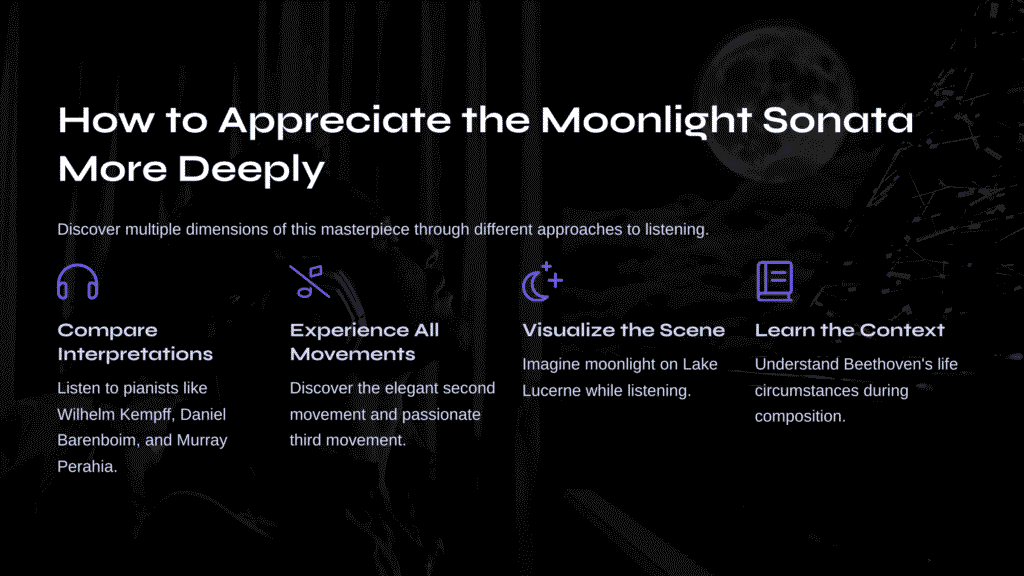
How to Appreciate the Moonlight Sonata More Deeply
For those wishing to appreciate this masterpiece more deeply, here are some tips:
- Compare Different Performers’ Interpretations: Listen to world-class pianists like Wilhelm Kempff, Daniel Barenboim, and Murray Perahia. The same piece tells completely different stories depending on the performer.
- Experience the Complete Sonata: The Moonlight Sonata consists of three movements. While the first movement is famous, listening to the elegance of the second movement and the storm-like passion of the third provides a deeper understanding of Beethoven’s genius.
- Focus on Auditory Imagery: While listening to the first movement, imagine Rellstab’s “moonlight on the lake” imagery. Consider how the wavelike triplet accompaniment and melody create this atmosphere.
- Understand the Historical Context: Learning about Beethoven’s life and the historical and personal circumstances during which this piece was composed can enrich your appreciation of the music.
- Close Your Eyes and Immerse Yourself: Sometimes, setting aside all analysis and simply surrendering to the emotions conveyed by the music is the purest way to experience it.
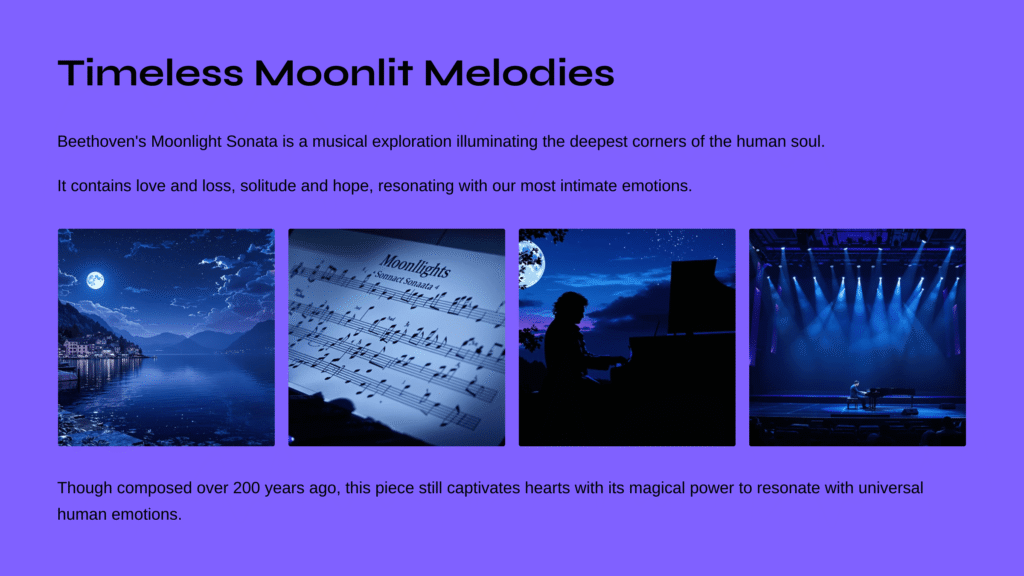
Timeless Moonlit Melodies
Beethoven’s Moonlight Sonata is not merely a piano piece. It is a musical exploration illuminating the deepest corners of the human soul, a lyrical poem containing love and loss, solitude and hope. Through the piano, Beethoven created a musical language that resonates with our most intimate emotions.
Though more than 200 years have passed since its composition, the reason this piece still captivates so many hearts lies herein. The Moonlight Sonata possesses a magical power that resonates with universal human emotions, transcending time and borders.
I invite you to find a quiet moment this evening to listen to these moonlit melodies. Feel what stories the music tells in your heart. Perhaps it will be more than just an appreciation of music—it might become a journey into your own inner self.
If You Loved This, Listen to This Next
If you enjoyed the evocative melodies of Beethoven’s Moonlight Sonata, you might also be captivated by Rachmaninoff’s “Vocalise” – a wordless vocal composition that conveys profound emotion through pure melody.
